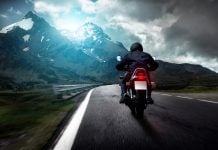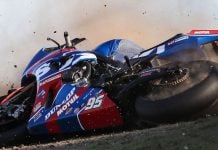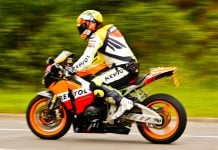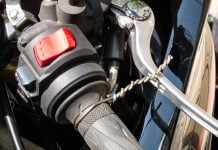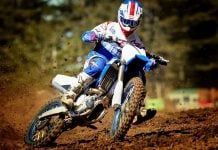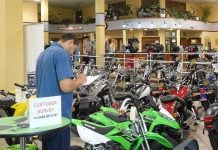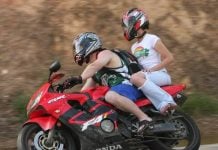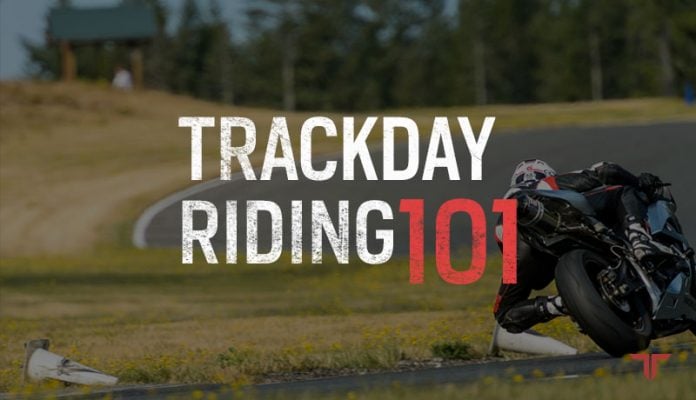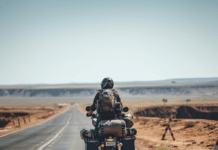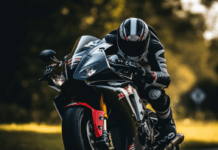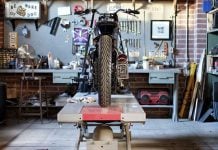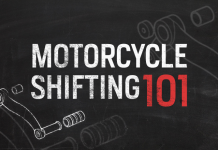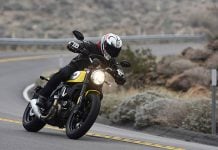You’ve had a few close-calls on the street. One too many white-knuckled moments with distracted drivers, deer, or unpredictable road conditions have left you shaken and thinking about hanging uptake helmet entirely. You don’t want to give up your passion for motorcycling but yearn for somethings after than the street.
All of these riders are searching for a new way to expand their skills.
Table of Contents
Overview
We’ll walk you through the process of getting to the track for the first time from start to finish.
First, we’ll investigate why track clubs exist, what makes a good club, and a good track. Then we’ll take a look at your riding gear and your mental and physical preparation.
Why Trackday?
Late model motorcycles are incredible exhibitions of technology and engineering. Even touring motorcycles now eclipse that level of technology and performance needed to ride on the street.
Sportbikes are race machines with the minimum done to pass emissions and safety regulations.
The track is the only place you can explore the limits of these machines.
The track provides a controlled, repeatable environment while removing the degree of uncertainty present in street riding. There are no cars, no wildlife, no pedestrians, and everyone is going in the same direction.
It provides a better environment to explore the limits of you and your machine than the street ever could.
Track riding also changes your perspective on street riding. After a track day you discover just how slow your backroads riding pace really is and expose the true risk of riding fast on public roads.
Your average street pace will begin to slow and you start enjoying street riding more for the social aspect with other riders rather than searching for thrills.
Finally, it’s fun. You will meet some of the most interesting, supportive, fiendly people from all walks of life and share an experience few will have in their lifetimes.
Common Misconceptions
There are always a few rumours about track riding, but the truth is the majority of motorcyclists will never step foot on a race track. Let’s walk through the most common misconceptions:
The track is dangerous
While crashes do happen, injuries are uncommon. Medical assistance is always nearby and the fatality rate is far lower than street riding.
The track is racing
Even though hosted at a race track, a track day is absolutely not a race event and most track clubs expressly forbid any actions attempting to make it so.
I’ll be too slow!
It’s rare that a rider shows up at a track day and there isn’t another rider at the same skill level.
I’ll wreck my bike!
Highly unlikely! New riders rarely crash on their first day, nor their entire first season.
I don’t have the right bike for it
Even if you don’t have a late model sport bike or performance oriented machine, most track clubs allow you to ride just about anything long as it is in good mechanical condition.
I need to buy all-new gear.
The gear requirements for track riding are more comprehensive than street riding.
This is only for thrill-seeking lunatics
A track day is for any motorcyclist looking to become a better rider. Regular track riders approach track days with the same pragmatic risk assessment all motorcyclists use.
I have to do a lot of bike setup
As long as your motorcycle is in good repair, most clubs only require you to tape up or remove the lights and mirrors.
I have to safety wire my bike
Safety wire is frequently used on race machines to keep fasteners from backing out of their threads under high stress.
Track riding is too expensive
It can be, however it doesn’t have to be. For the new
You & Your Gear
Before signing up for you first track day take a survey of your physical and mental fitness.
Riding a motorcycle at speed is mentally and physically exhausting and track riding has higher requirements for riding gear than the typical street ride.
Your Body
Riding a motorcycle on a race track is physiologically demanding.
Your body will be exposed to extreme sensations of acceleration, wind noise and physical exertion.
When was your last physical? If it was been a while, you man want to schedule one and get some physical health checks out of the way.
While it may not be a tremendous factor no your first day, your physical fitness becomes ingreasingly important the more experience you gain on the track.
While bicycling is ahiglhy effective form of cross training used by track riders all the way up to profesisonal racers, use whatever fitness regimen makes you comfortable.
Your Riding Gear
Some track organizations rent riding gear. While this is adequate for your first track day, bew arned the quality and condition of what’s available can vary greatly from club to club and it may be to purchase the riding gear up front.
Suit: While most track clubs will allow textile suits and two pieces at a minimum, if planning more track days in the future it’s best to make the purchase of a one piece leather suit up front.
Helmet: If your current street helmet is DOT and SNELL approved full-face it will suffice.
Gloves: Most clubs require
Boots: Your current street boot may already satisfy the requirements of your local track club. Sport boots usually feature a minimal heel to allow faster transition from the footpeg to the controls, right soles for increased bike feel and protection, toe sliders to prevent asphalt contact from forcing your foot off the peg or rotating your foot in a crash.
Ear plugs: Wind noise is damaging to your hearing and wearing ear plugs is a good habit to get in to.
Back protector: Track clubs require a hard shell back protector and its importance cannot be overstated.
Base layer: Leathers are difficult to take on and off when hot and sweaty. A synthetic moisture wicking layer makes this easier as well as providing additional comfort.
Staying warm: Being that track riding is physically demanding your body will be warmer than street riding. On cold days do all of your layering below your leathers and switch to winter gloves and wool socks.
Your Bike
For your first track day the answer is the one you already have.
Despite all the marketing, the latest 200HP superbike is not the best motorcycle to become a great track rider on. High horsepower machines hinder a new-track rider’s learning because managing the power distracts from the more important techniques of riding such as line choice, throttle control, and bosy position.
Bike Maintenance and Setup
Before registering for your first track day thoroughly inspect your motorcycle using the tips below:
Most importantly inspect your braking system first. Even a novice rider at the track will stress the braking system far more than they have before.
- Brake fluid: The most common brake-related failure at the track is over-heated brake fluid. Hard braking causes increased temperature throughout the entire system and fluid that’s old.
- Rotors: Elevate the wheels and spin them by hand and listen to the sound of the brake pads sliding agaisnt the rotors. Does the nois get louder at one spot of the rotor? A warped rotor will cause more heat to enter the brake system and increase the chances of brake fluid failure.
- Pads: Finally, inspect your brake pads. Stock pads are plenty sufficient, but they will wear much faster on the track. Ensure there is an ample chunk of pad left.
As the second most important components on the track, verify your tires, suspension, and wheels are in excellent working condition.
- Tires: For your first track day, even touring tires are sufficient as long as they are less than 2 years old and have at least 70% tread left.
- Tire Pressure: Set your tire pressure while your tires are cold the morning of your track day. Tire pressure varies depending on bike weight, tire type, ambient air, and surface temperature. A good starting point for a sportbike on typical
perfomance tires is 32-34psi front and 36-38psi rear. - Wheel bearings: ELevate both wheels of the motorcycle. Grab the wheel by the tire on the left and right and attempt to rock it back and forth. If any
play in the bearings is felt, its time to replace them. - Headstock bearings: Apply the front brake and rock the front of the motorcycle back and forth from the handlebars. If any visible play is seen, the headstock may need a simple adjustment. If any notchiness is felt, the headstock bearings need to be replaced.
- Suspension
adjusment : If your suspension is adjustable set your static and rider sag at a minimum. Otherwise, leave your suspension setup as-is if you’re comfortable with it and make further adjustments at the track if necessary. - Controls:
Smoth , easy to operate controls will go a long way towards your enjoyment at the track. If the clutch, brakes, and throttle take more effort than needed you will find your hands and forearms getting tired quickly. This is called arm pump. - Levers and footpegs: First, inspect your levers. If they are bent, damaged or broken replace them. The metal balls on the ends of motorcycle levers are
deisgned to prevent levers from becoming knives in a crash and you will fail tech inspection if they are missing. - Clutch: Adjust your cables for correct
freeplay . Make sure your clutch isn’t slipping, a common way to check is to accelerate rapidly uphill in 3rd gear. If the RPMs climb rapidly with little acceleration, your clutch may need to be replaced. - Throttle:
Verifiy thetrottle snaps closed when turned. If it doesn’t, verify the cable routing is correct and no pinching or binding occurs when the bars are turned from lock to lock. - Cables: Inspect your clutch and throttle cables for fraying, proper play adjustment, and are free of dirt. Use a cable
luber and a silicone-based lubricant to service your cables. - Shift Pattern: Track-only machines frequently run a reverse shift pattern of “GP” shift which reverses the shift pattern from standard (push down to change up a get instead of pulling up). This allows easier upshifts with the motorcycle leaned over in
left hand corners when ground clearance makes it difficult to get the rider’s foot beneath the shifter. For your first track day keep the shift pattern the same.
Fluids are also very important, see our recommendation below:
- Coolant: Check with your local club to determine what thei rules for oil and coolant. Ethylene glycol based coolants are slippery and can result in downtime while the track is cleaned in the event of a spill.
- Oil: Most clubs do not require the oil filler, drain plug, and filter to be safety wired in the novice group at track days. For peace of mind, it’s simple enough to wrap the oil filter with a hose clamp, then safety wire the clamp to a nerby frame-member to keep the filter from loosening. Finally verify your oil is relatively fresh and at the correct level.
Lights and indicators: Completely cover lights and indicators with painter’s tape and cover or remove the mirrors completely. Contrary to common belief, lights and mirrors are not taped up to prevent debris from spreading across the track in a crash. Most lights are plastic and don’t shatter.
The primary reason is to reduce distraction to you and riders around you.
When tail lights are visible, the added distraction tends to cause riders to stop picking their ou braking points.
Novice track riders have a tendency to use their mirrors to avoid faster riders coming up behind them.
Removing or covering your mirrors forces you to do the right thing by only paying attention to what is in front of you.
Booking your day & getting there
Most clubs have a few different levels of membership.
Usually they’re based on how many days a rider plans to attend per year with various discounts per membership tier.
Thankfully, you can always register for a track day as a guest. For your first track day this is the best option. If you get hooked, you can always become a club member later.
Booking a track day
Most clubs allow you to register online so the process of signing up should be relatively straightforward.
Lodging
Unless you’re lucky enough to live within reasonable driving distance plan on staying at a hotel withing 30 minutes of the track the night before. Race tracks are usually in remote areas and lodging costs are reasonable.
Getting there
While there is nothing stopping you from riding your bike directly to the track, there’s good reason not not.
You won’t be able to carry the support equipment that makes your day better such as a popup shade, tools and spare parts.
When leaving the track your senses will be dulled from the day and you will be mentally and physically exhausted, making the ride home even more dangerous.
If you don’t own a truck or trailer, there are a few other strategies for getting to the track.
What to bring
Below are a few things that are worth discussing in detail:
- Motorcycle key: Go put it in your truck right now. If you have a locked trailer consider securing it to the steering yoke of your motorcycle with a cable tie. It seems
ismple enough, but riders forget their motorcycle keys frequently and modern motorcycle ignitions are difficult to bypass. - Fuel: At a typical track day you’ll counsume around five gallons of fuel excluding what’s in your bike already. Some tracks don’t offer fuel and those that do are astonishingly expensive. So plan on brining at least 5 galons in addition to what’s in your bike already.
- Shade: Tracks tend to be featureless landscapes and shade can be hard to find. A pop-up canopy is extremely helpful in offering shelter from the sun for you, your motorcycle, and gas.
- Compressed air: A simple air tank, bicycle pump, or 12V emergency tire compressor is sufficient to adjust your tire pressure as needed.
- Bicycle: Tracks are large places and walking around in leathers and race boots is tiring. A bicycle or small scooter is great for getting around the pits and seeing the track from as many areas as possible.
- Food and hydration: A couple of light snacks and a decent lunch are all that’s needed. Track riding is extremely athletic and you’ll consume substantial energy throughout the day. So don’t forget to bring enough fluid.
- Friend: An extra set of hands is extremely helpful loading and unloading your bike. They can also help you take pictures, observe your riding, help you drive home, and it’s a great way to introduce someone to performance motorcycling.
Loading a motorcycle
It may seem simple to load a motorcycle into a truck or trailer but it takes practice and simple precautions to do it safely. Here is a proven method to keep from dropping your bike:
- Find two ramps, straps and a friend to help as a spotter.
- If possible, park the truck on a slight downhill, or back the truck up to a small ledge to reduce the angle of the ramp into the pickup bed.
- Strap the ramps into the truck. Place the ramps at an appropriate distance.
- Line up the motorcycle with the ramp and have a spotter stand on the opposite side.
- Start the motorcycle and put it in first.
- Use the power of the engine and the clutch to carefully power-walk the bike up the ramp. As you go up the ramp, walk up the other one or use the stool to step into the truck.
- Roll foward and carefully chock the front wheel against the front of the truck.
- Secure the front of the bike using straps.
- Secure the rear of the bike just enough to prevent it from moving side to side.
Your first track day
Arriving and unloading:
Plan to wake up early, eat breakfast, drive from your hotel, and arrive when the gates open.
Perform all the bike setup and verifications.
Upon arriving, park in a location that allows adequate space for your equipment. Then proceed to registration and check-in.
Once registered, begin unloading your motorcycle and setting up your pit area. If you’re alone and nervous unloading your motrocycle, ask for help without hesitation.
Tech inspection
Tech inspection is usually open from when the gates open until just before the riders’ meeting.
Most of what is required at tech inspection was covered about bike setup and riding gear.
The rider’s meeting
Typically the rider’s meeting occurs after tech inspection and just before the first session. It is organized by the club and rider coaches.
The most important information reviewed during the rider’s meeting is track conditions for the day.
The rider’s meeting is also a great forum for questions. Don’t be reserved; there is always another rider with the same question that is also too embarrassed to ask.
Track walk
If time and your club allows, walk around the track.
Walking the track helps you see details and pavement irregularities you would otherwise miss traveling at high speed.
Track etiquette
Entering the track (pit-out): Enter the track carefully and predictably. New riders occasionally make the mistake of thinking they need to swoop into the racing line as quickly as possible when joining a hot track.
Exiting the track (pit-in): There will be a designated place to exit the track, liekly the last corner before the finish line or pint entrance. Pit in by putting a hand up before the last corner to signal to other riders that you’re going to leave the race line but do not slow down. Keep your hand up or remove a foot from the footpeg and keep it there until you’ve successfully exited the track.
Don’t be a straight-away hero: I is extremely frustating to fast riders if you are holding them up on the technical parts of the track and during the straights, so let them pass to prevent the track from bunching up.
What to do when a faster rider is behind you: Hold your line. After all, they caught up to you and it is their responsiblity to make a safe and predictable pass. Do not attempt to move out of their way. If they can’t make the pass easily in the corners, let them by on the next straight.
Passing other riders: Follow the passing rules of your group in the club you are riding with. Do not pass on the inside before the apex of a corner. When passing on the inside before the apex, the outside rider can turn directly into the inside rider causing a crash.
A rider crashes in front of you: Do not stop, slow down, or alter your line unless you have to. Frequantly crashes happen in pairs when one rider goes down and the rider behing fixates on them and follows directly off the track.
riding and general tips
Look where you want to go
Bike and body go where the eyes look. Novice riders tend to look only 15 feet in front of their front fender, struggle to link up their lines, and are riding the track one corner at atime.
Save for the straights, a track is usually a series of flowing corners. By looking further ahead a rider can begin to discover the flow of a track and link together their lines.
Check your fuel level before each session
Motorcycles consume a surprising amount of fuel at the track.
There’s nothing worse than seeing your fuel light come on while lining up for your session.
Give your tires time to warm up
Most crashes at the track happen on the first or second lap of a session due to cold tires. Pay careful attention to this in the morning when the track surface tends to be cooler.
Don’t focus on getting your “knee down”
Dragging a knee for the first time is an unforgettable feeling. However, don’t focus on it your first day. Focus on finding the race line, maintaning correct body position, and it will happen when you’re least thinking about it.
The aggressive rider vs. the smooth rider
The aggressive rider is hard on the throttle, hard on the brakes, shifting through every gear, wagging the tail on corner entry with the chassis moving around violently on corner entry and exit due to weight transfer.
The smooth rider is looking far down the track, riding a gear higher, calmly rolling on the throttle, slowly transitioning to the brakes, and conserving momentum. Rider and bike flow around the track effortlessy.
The aggressive rider is turning the curves of the track into angles by firing in and out of corners, hard on the gas and brakes. This rider has little margin for error because they are already overriding the chassis and suspension. The smooth rider is safer because they are not as close to the ragged edge. By riding smoother lines, conserving momentum, and linking the track together they have headroom in the chassis, suspension, and brakes to react to mistakes. Novice riders frequently develop into the aggressive rider because it feels faster. However, the rider that looks the fastest is not always the fastest all the way around the track. While the aggressive rider may be faster in technical sections of the track, the smooth rider is usually faster overall because they are conserving momentum. The smooth rider has the faster, safer lap time. Take caution starting the day and ending
Take caution starting the day and ending the day
Most crashes happen in the first session of the day and the last session of the day. In the morning the track and tires are cold, riders have the highest nerves, haven’t warmed up their bodies and found the “groove” yet. Towards the end of the day, tires are worn, riders are tired, and the track surface may be so hot that tires are overheated.
Tank slappers and how to handle them
A tank slapper occurs when the front tire lands crooked off the centerline of the motorcycle and quickly deflects in the opposite direction, typically from a small wheelie. In extreme cases the front tire can continue deflecting violently from side to side on the steering axis until the rider crashes.
There’s not much you can do to contorl a tank slapper besides staying on the throttle. However, imeediately after a tank-slapper, pump the brakes. The force of a tank slapper can be so violent that the mass of the brake pads forces the brake pistons away from the rotor while the front wheel oscillates. Pump the brakes several times or there may be no brake pressure entering the next corner.
Flags and what they mean
Flag rules vary slightly from club to club and are almost always covered in the rider’s meeting. Below are some of the most common flags and what they mean about track conditions.
Green flag: The track is hot, proceed as normal. Green flags are typically shown at the start of a session and after a track section was under a standing yellow flag and is now clear.
Yellow flag: There is a hazard on the track. Slow your speed and do not pass. This can be anything from a downed rider to a chemical on the track.
Red Flag: There is an incident on the track that affects all riders and the session is over. Slow down, do not pass, and proceed to pit exit and pit-in. After exiting the track await further instruction.
Black flag: There is a visible mechanical issue with your bike, or you’ve violated rules of conduct on the track maintain pace, proceed to pit exit and pit-in immediately.
Blue flag: There is a faster rider behind you, allow them to overtake you. While rare at track days, some club use the blue flag to allow faster riders pass other riders in the group in a controlled and predictable manner.
Checkered flag: Your session is over proceed to pit exit and pit-out.
Lunch time
Lunch is a good time to collect your thoughts and review how the day is going. Look over your bike for any mechanical issues, loose parts, chain tension, tire wear, and double check your fluid levels.
Finally socialize with other riders and rider coaches that may be riding in your group; they may have helpful insight about the track and your riding.
I crashed, now what?
It is very rare that riders crash on their first day, but if you do here is what you do to ensure your safety and the safety of riders around you.
- Relax and do nothing. Stay loose, relax, collect your bearings and tap the ground to verify you are no longer moving. Riders frequently become injured by attempting to stand up while still sliding at 20mph and tumbling. Verify you’re not injured, dizzy or
nauseos . - Exit the track. Stand up and
exis the track as quickly as possible. - Signal a corner worker. They
ahve likely already seenou crash and the yellow flags are already out. - Get behind the tire wall and wait until the session is over. Depending on
wherey our motorcycle is or why you crashed they may decide to red flag the session. - Assess the situation and follow your club’s rules. Once back in the pits, collect yourself, your gear, and decide what to do. Check your helmet for damage. If it shows the smallest sign of impact, your day is over.
Finishing up
After lunch you may find yourself becoming tired and your alertness declining. Take and index of your fatigue level and decide if that last session is really worth it. Crashes tend to happen most often in the beginning of the day and the end of the day.
If there is any doubt, sit the last session out. At this point, you likely know that you will be back soon, so better to pass on the last session when you are exhausted and come back next time.
